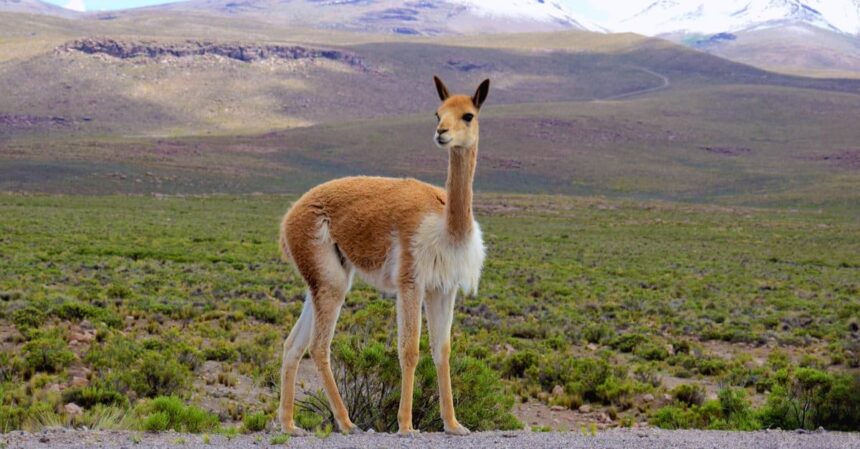The vicuna, a graceful and agile creature native to the high Andes of South America, is often overshadowed by its more famous cousin—the alpaca. However, this exquisite animal deserves attention not just for its stunning appearance but also for the incredible story of resilience it represents. With wool that rivals cashmere in softness and warmth, vicunas are not only vital to their ecosystems but have also become symbols of conservation efforts across the region.
Once teetering on the brink of extinction due to poaching and habitat loss, the vicuna has made remarkable strides toward recovery thanks to dedicated conservation initiatives. But challenges still loom large over their future. As we delve into the complex history and current plight of this magnificent species, we’ll explore how sustainable practices can ensure that these enchanting animals continue to thrive in their natural habitats for generations to come. Join us as we uncover The Vicuna Legacy—a tale woven with threads of hope, challenge, and determination.
History of the Vicuna and its Decline
The vicuna, a wild relative of the alpaca, roamed the Andean mountains for centuries. Revered by ancient civilizations, it was prized for its incredibly soft wool. The Incas regarded this animal as sacred and even reserved its fibers exclusively for royalty.
However, during the 19th century, demand surged dramatically. Poachers hunted vicunas relentlessly to exploit their coveted fleece. This led to drastic declines in their population across Peru, Bolivia, Chile, and Argentina.
By the mid-20th century, numbers had plummeted dangerously low. Habitat destruction coupled with overexploitation brought vicunas close to extinction. They faced dire challenges from grazing livestock that encroached on their natural habitats.
Conservationists began to recognize the urgent need for action as awareness grew about this remarkable species’ plight. Their journey from near disappearance set the stage for future efforts aimed at saving them from oblivion.
Conservation Efforts and Success Stories
Conservation efforts for the vicuna have shown remarkable success in recent decades. Collaborative initiatives between local communities, governments, and NGOs have revitalized populations that once faced severe decline.
One noteworthy project is the establishment of protected areas across the Andes. These reserves serve as safe havens for vicunas to thrive without poaching threats. In regions like Peru and Bolivia, strict regulations on hunting and trade have been enforced.
Community involvement has also played a crucial role. Local herders now participate in sustainable practices that allow them to harvest wool without harming the animals. This shift not only empowers communities but also fosters a deeper connection with wildlife.
Additionally, educational programs raise awareness about vicuna conservation among younger generations. By instilling appreciation for this majestic animal, these initiatives ensure ongoing support for future conservation measures. The progress made underscores how united efforts can create tangible change in protecting this iconic species.
Current Threats to the Vicuna Population
The vicuna faces several ongoing threats that jeopardize its survival. Habitat loss is one of the most pressing issues. Expanding agriculture and infrastructure development encroach on their natural environments, fragmenting populations.
Poaching remains a significant danger as well. The demand for their fine wool drives illegal hunting practices, which can decimate local herds. Despite strict regulations, enforcement in remote areas often proves challenging.
Climate change also poses a risk by altering the delicate ecosystems where vicunas thrive. Changes in temperature and precipitation patterns affect food availability and habitat suitability.
Moreover, competition with livestock adds to the stress on vicuna populations. As domestic animals graze on shared resources, vicunas face increased pressure for survival within their habitats.
Sustainable Use and Economic Benefits of Vicuna Conservation
Sustainable use of vicunas plays a crucial role in their conservation. By focusing on responsible management, communities can benefit while protecting these magnificent animals.
The collection of vicuña fiber is a prime example. This soft and luxurious material commands high market prices. When sourced sustainably, it provides income for local populations without harming the species.
Communities engaged in sustainable practices often see increased tourism as well. Eco-tourism centered around vicuna habitats attracts visitors eager to witness these creatures in their natural environment. This fosters an appreciation for biodiversity and enhances conservation efforts.
Additionally, educational programs raise awareness about the importance of preserving the vicuna legacy. These initiatives empower locals with knowledge about environmental stewardship, ensuring future generations value their unique heritage.
Balancing economic benefits with ecological responsibility creates a win-win scenario for both humans and wildlife alike.
Future Plans for Protecting the Species
Future plans for protecting the vicuna hinge on collaborative efforts among governments, conservation organizations, and local communities. Increased awareness of the species’ plight is crucial. Education campaigns are being designed to inform people about sustainable practices that benefit both vicunas and their habitat.
Enhanced protection measures in national parks and reserves will be prioritized. These areas serve as critical sanctuaries for the species. Implementing stricter regulations against poaching can help ensure a safer environment.
Additionally, ecotourism initiatives are gaining traction. They offer economic incentives while promoting wildlife observation rather than exploitation. Communities can thrive by showcasing this majestic animal in its natural setting.
Research plays a vital role too; ongoing studies aim to better understand vicuna behavior and genetics. This knowledge will aid in developing more effective conservation strategies tailored to their needs over time.
Conclusion: The Importance of Preserving the Vicuna Legacy
The vicuna is more than just a beautiful animal; it represents resilience and the delicate balance of our ecosystems. Its legacy is tied deeply to the culture and survival of local communities. Protecting this species goes beyond conservation efforts; it promotes sustainable practices that can enhance livelihoods.
As we reflect on the journey of the vicuna, it’s clear that every action counts. Each small step in conservation can lead to significant impacts on their population numbers. The collaboration between governments, NGOs, and local communities has shown what’s possible when united for a cause.
Preserving the vicuna not only safeguards biodiversity but also enriches humanity’s connection with nature. By ensuring its future, we honor an invaluable part of our planet’s heritage—a legacy worth fighting for as we look towards generations ahead.


